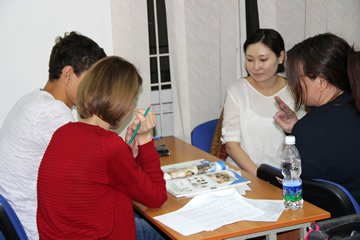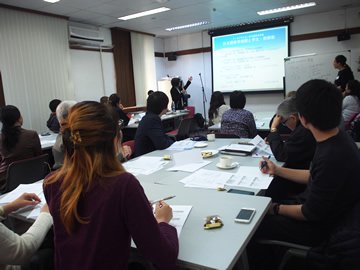Hello at 800 Meters
Kyrgyz Republic-Japan Center for Human Development
MUNAKATA Minami
The Kyrgyz Republic a mountainous country located in Central Asia, covering an area roughly half that of Japan, with a population of approximately six million people. Both Kyrgyz and Russian are official languages, and people can be seen mixing the two languages in conversation in the capital city of Bishkek.
When the locals, such as airport customs agents, shop staff, or taxi drivers, realize that I’m Japanese, they react in a friendly manner, such as telling me the taxi was made in Japan, or asking how to say hello in Japanese, demonstrating that the people here have a greater familiarity with Japan than we in Japan might think. So, in this article I would like to give a brief introduction of the Japanese-language education situation in Kyrgyzstan. As far as we can measure, there are currently around 1,000 Japanese-language learners in Kyrgyzstan. That number is not so small considering that it takes a day to reach Japan from this small nomadic country.
The Japanese-Language Course at the Kyrgyz Republic-Japan Center for Human Development
I have been dispatched to the Kyrgyz Republic-Japan Center for Human Development (hereinafter the “Center”). The Center primarily operates three pillar programs, which are the business course, Japanese-language course, and the mutual understanding promotion program.
The Japanese-language course is held by the Center twice per year. The course, which uses the Marugoto: Japanese Language and Culture series, primarily consists of six or seven classes ranging from Starter to Intermediate 2, but there is also an early advanced course that started in February 2017 geared towards students who have exceeded Intermediate 2. A wide range of people with diverse backgrounds study Japanese at the Center, from upper secondary school students and working adults to retirees. The reasons they began studying are also diverse, including an interest in Japanese Anime from childhood, interest in Japanese technology, and a desire to study in Japan. While the Japanese-language course is not large overall, with classes ranging from 5 to 30 students, the students are almost always smiling and each gets a chance to speak due to the small class sizes. In addition to running courses, the Center also carries out a variety of other activities such as sushi roll making through inter-class exchange, a Japanese Karaoke contest, a Kakizone New Year’s calligraphy competition, presentation events in Japanese, and visits to schools in Bishkek.

Group discussions during a Marugoto Starter’s course.
The students practice the words they just learned.
Japanese Language Teachers Association of the Kyrgyz Republic
The Japanese Language Teachers Association of the Kyrgyz Republic (hereinafter “Association”), of which 43 Japanese teachers from local institutions are members (as of May 2017), are another essential part of local Japanese-language related activities.
Since it was founded in 1999, the Association has been making a major contribution to Japanese-language education in Kyrgyzstan. The primary activities of the Association at present are planning and management of the Japanese Speech Contest, implementation of the Japanese-Language Proficiency Test (JLPT), the publication of the Association newsletter two or three times per year, and visiting classes in regional areas. The Speech Contest and JLPT in particular are valuable opportunities for local learners to test their Japanese language skills in this country far from Japan.
The 21st Central Asia Japanese Speech Contest and the Central Asia Japanese-Language Education Seminar
The 21st Central Asian Japanese Speech Contest was held in Kyrgyzstan on April 29, 2017. A total of 17 learners competed in the contest from a total of five countries, including Uzbekistan, Kazakhstan, Tajikistan, and Turkmenistan in addition to Kyrgyzstan. The overall level of the Japanese speeches was extremely high, impressing the attendees.
The Central Asia Japanese-Language Education Seminar was then held on the following day. In addition to lectures and workshops on student motivation led by Japanese-Language Specialists assigned to Uzbekistan and Kazakhstan, presentations were also given on practice and research for the Central Asian region.
I have the utmost gratitude for the members of the executive committee who managed the program from the planning stage, the many institutions that supported the management of the event, and the contestants, leading teachers, and supporters.

The 21st Central Asia Japanese-Language Education Seminar.
A presentation is being given on the foundation of the Association of Japanese-Language Teachers in Tajikistan
Challenges for Japanese-Language Specialists
The activities of Japanese teachers in Kyrgyzstan have been expanding to the realm of research including the publication of the “Kyrgyz Japanese-Language Education Research” bulletin and the hosting of international seminars. Japanese-Language Specialists are being called on to take the initiative in both the classroom and research to cooperate with neighboring countries and lead the Japanese teachers in the Central Asian region.
Though there are many things that the Japanese-Language Specialists must take on, such as continuing to provide learners with opportunities to use their skills, increasing the number of JLPT test takers, holding Japanese-language teacher training programs, domestic off-site visits, and working with institutions both inside and outside the country, I hope to be of help to as many students and teachers as I can during my deployment.
- What We Do Top
- Arts and Cultural Exchange [Culture]
- Japanese-Language Education Overseas [Language]
- Japanese-Language Education Overseas [Language] Top
- Learn Japanese-language
- Teach Japanese-language
- Take Japanese-Language Test
- Know about Japanese-language education abroad
- The Japanese-Language Institute, Urawa
- The Japanese-Language Institute, Kansai
- Japanese-Language Programs for Foreign Specified Skilled Worker Candidates
- Japanese Language Education for Japanese Children Resident Overseas and for the Descendants of Migrants
- Archives
- Japanese Studies and Global Partnerships [Dialogue]
- JF digital collection
- Other Programs / Programs to Commemorate Exchange Year
- Awards and Prizes
- Publications
